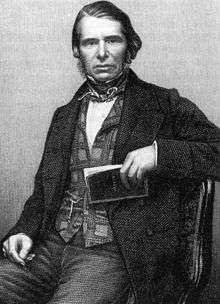Trevelyan baronets
There have been two baronetcies created for members of the Trevelyan family (pronounced "Trevillian"[2]), one in the Baronetage of England and one in the Baronetage of the United Kingdom. As of 2014, both creations are extant.


1st Baronet, of Wallington
Origins
The family derived its surname from the manor of Trevelyan in the parish of St Veep, Cornwall, situated in the ancient hundred of West Wivel, called Trewellen in the Domesday Book of 1086,[3] and shown in the British Ordnance Survey map of 1890 as located about one mile east of Penpoll.[4] A different manor named Trevelien in 1086 (now named Trevillyn) is in the adjacent hundred of Powder.[5]
The Trevilian, later Trevelyan Baronetcy, of Nettlecombe in the County of Somerset, was created in the Baronetage of England on 24 January 1662 for George Trevilian.[6] He was the son of George Trevilian, a member of the Somerset gentry and a supporter of the Royalist cause in the Civil War. The 2nd Baronet sat as a Member of Parliament for Somerset and for Minehead. He changed the spelling of the family surname to Trevelyan. The 4th Baronet was a Member of Parliament for Newcastle-upon-Tyne and for Somerset. The 8th Baronet served as High Sheriff of Cornwall for 1906-7. As of 28 February 2014 the present Baronet has not successfully proven his succession and is therefore not on the Official Roll of the Baronetage, with the baronetcy considered dormant since 1976.[7]
Prominent members of the senior branch included: The Venerable George Trevelyan (third son of the 4th Baronet), Archdeacon of Taunton in Somerset. His third son Henry Willoughby Trevelyan was a Major-General in the British Army. His younger son Sir Ernest John Trevelyan (1850–1929) was a Judge of the High Court of Calcutta, a writer on legal matters and a member of the Oxford Town Council. Humphrey Trevelyan, Baron Trevelyan, son of the Reverend George Philip Trevelyan, son of the Reverend William Pitt Trevelyan, sixth son of the aforementioned the Venerable George Trevelyan, was a diplomat and author. See below.
The Trevelyan Baronetcy, of Wallington in the County of Northumberland, was created in the Baronetage of the United Kingdom on 13 March 1874 for the civil servant and colonial administrator Sir Charles Trevelyan, 1st Baronet. The estate of Wallington was inherited by Sir George Trevelyan, 3rd Baronet (1707–1768) from his wife Julia Calverley, daughter of Sir Walter Calverley, 1st Baronet, and his wife Julia Blackett, heiress of Wallington Castle, rebuilt by the Blacketts in the 1689s, who purchased it from the Fenwick family.[8] The 1st Baronet was the son of the aforementioned Venerable George Trevelyan, third son of the fourth Baronet of the 1662 creation (see above). The 2nd Baronet, George Otto Trevelyan, was a prominent historian and Liberal politician. The 3rd Baronet, Charles Phillips Trevelyan, was a Liberal, and later Labour politician. The 4th Baronet, George Lowthian Trevelyan, was a teacher, craftsman in wood and New Age thinker. Three other members of this branch of the family may also be mentioned. R. C. Trevelyan, second son of the 2nd Baronet, was a poet and dramatist. His son Julian Trevelyan is a painter. G. M. Trevelyan, third son of the 2nd Baronet, was a distinguished historian. The family seat is Wallington Hall, near Cambo in Northumberland.
Trevilian, later Trevelyan baronets, of Nettlecombe (1662)
- Sir George Trevilian, 1st Baronet (c. 1635–1671)
- Sir John Trevelyan, 2nd Baronet (1670–1755)
- Sir George Trevelyan, 3rd Baronet (1707–1768)
- Sir John Trevelyan, 4th Baronet (1735–1828)
- Sir John Trevelyan, 5th Baronet (1761–1846)
- Sir Walter Calverley Trevelyan, 6th Baronet (1797–1879)
- Sir Alfred Wilson Trevelyan, 7th Baronet (1831–1891)
- Sir Walter John Trevelyan, 8th Baronet (1866–1931)
Trevelyan baronets, of Wallington (1874)
- Sir Charles Edward Trevelyan, 1st Baronet (1807–1886)
- Sir George Otto Trevelyan, 2nd Baronet (1838–1928)
- Sir Charles Philips Trevelyan, 3rd Baronet (1870–1958)
- Sir George Lowthian Trevelyan, 4th Baronet (1906–1996)
- Sir Geoffrey Washington Trevelyan, 5th Baronet (1920–2011)
- Sir Peter John Trevelyan, 6th Baronet (born 1948)
The heir apparent is the present holder's only son Julian Miles Trevelyan (born 1998).[9]
Further reading
- Laura Trevelyan, A Very British Family: The Trevelyans and Their World, London, 2006
Notes
- Debrett's Peerage, 1968, p.798
- Montague-Smith, P.W. (ed.), Debrett's Peerage, Baronetage, Knightage and Companionage, Kelly's Directories Ltd, Kingston-upon-Thames, 1968, p.798
- Powell-Smith, Anna. "Trevelyan | Domesday Book". opendomesday.org. Retrieved 2018-03-11.
- 0.9 miles east of Penpoll on the south side of the intersection of Route B3389 with an east-west road.
- Powell-Smith, Anna. "Trevillyn | Domesday Book". opendomesday.org. Retrieved 2018-03-11.
- Cokayne, George Edward, ed. (1903), Complete Baronetage volume 3 (1649-1664), 3, Exeter: William Pollard and Co, retrieved 9 October 2018
- "Official Roll of the Baronetage » The Standing Council of the Baronetage -". baronetage.org. Archived from the original on 2015-03-06. Retrieved 2018-03-11.
- Laura Trevelyan
- "Person Page". thepeerage.com. Retrieved 2018-03-11.
References
- Official Roll of the Baronets. Standing Council of the Baronetage. 1997.
- Kidd, Charles, Williamson, David (editors). Debrett's Peerage and Baronetage (1990 edition). New York: St Martin's Press, 1990,
- Lundy, Darryl. "FAQ". The Peerage.
- Brief biography of Sir Ernest John Trevelyan
- This page incorporates information from Leigh Rayment's Baronetage Page which has further dates on it, not shown above.
Further reading
- A very British family: the Trevelyans and their world, by Laura Trevelyan. I.B.Tauris, 2006. ISBN 1-86064-946-7.